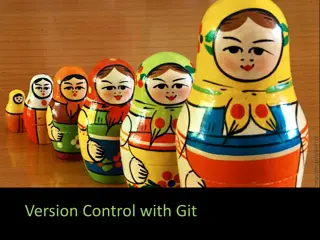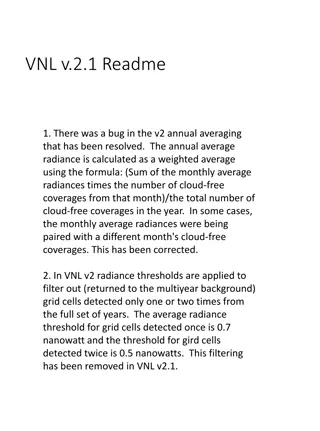Update Summary of Changes in int2lm Version 2.05 by Ulrich Blahak (2017)
Changes in int2lm towards version 2.05 presented by Ulrich Blahak at the COSMO General Meeting in Jerusalem include modifications to non-hydrostatic input models (COSMO, ICON, UM) with bug fixes and method improvements affecting pressure computation, soil temperature adaption, and vertical profile adjustments. The update also discusses the transition from version 2.03 to 2.05, detailing bug fixes, candidate status, and new features like processing COSMO external parameters and ECWMF aerosol fields.
Download Presentation

Please find below an Image/Link to download the presentation.
The content on the website is provided AS IS for your information and personal use only. It may not be sold, licensed, or shared on other websites without obtaining consent from the author.If you encounter any issues during the download, it is possible that the publisher has removed the file from their server.
You are allowed to download the files provided on this website for personal or commercial use, subject to the condition that they are used lawfully. All files are the property of their respective owners.
The content on the website is provided AS IS for your information and personal use only. It may not be sold, licensed, or shared on other websites without obtaining consent from the author.
E N D
Presentation Transcript
Changes in int2lm towards V2.05 Ulrich Blahak Deutscher Wetterdienst, Offenbach COSMO General Meeting, Jerusalem, 11.9.2017 1
Version naming Last official version: 2.02 2.03 (Feb. 2017): (handed out for further beta-testing) Contains all changes which have been presented at last years GM Further major changes for non-hydrostatic input models (ICON, COSMO, UM) Important bug fix in case of ICON input Some smaller bug fixes Shortly thereafter: Re-labeling to 2.04 (2.04a 1 bugfix) to be consistent with DWD- internal version control (otherwise, no changes of the content) Soon 2.04b = candidate for 2.05 (Sep. 2017): Smaller bugfixes Option to only process the COSMO external parameters Kinne aerosol climatology (from T2RC2) Processing of operational ECMWF aerosol fields (CAMS) (from T2RC2) 2
Modifications with considerable influence on results Concerning non-hydrostatic input models (COSMO, ICON, UM, CM(?)): New methods of adapting vertical profiles to new orography (deeper valleys, higher mountains in COSMO orography) --- all 3D variables except pressure Profiles of W blended to terrain following values (according to U and V) near the surface Computation of (hydrostatically balanced) pressure: pressure no longer interpolated but computed analytically from interpolated profiles of T and QV this is a bugfix rather than a change! Concerning soil temperature: Bugfix for ICON input only: Surface temperature T_SO (initial data) should be adapted to the new orography by way of conservation of differences to near-surface atm. T. But for ICON input, this was done wrong so that effectively T_SO was not adapted but only horizontally interpolated! For ICON/COSMO/IFS input: difference-based adaption of T_SO only near the soil surface. At deeper layers blending to a climatological height correction (-0.7 K / 100 m) 3
Pressure computation OLD inter- polation of PP higher mountain deeper valley problematic! inaccurate! 4
Pressure computation New: PP is no longer interpolated, but analytically computed (integrated) from hydrostatic equation, based on the before interpolated T- and QV profiles: 5
Pressure computation OLD NEW level 4: height ~ 18 km flat surface 6
Resulting noise in COSMO-DE OLD PP NEW PP NEW PP + NEW PROFILE METHODS (see following slides) DPSDT 7
OLD profile methods for other vars OLD deeper valley higher mountain 8
New profile methods for other vars NEW gradient extrapol. + linear transition gradient extrapol. + linear transition deeper valley gradient extrapol. + linear transition + terrain following Tracers: gradient extrapol. + linear transition gradient extrapol. higher mountain Tracers: linear transition linear transition + terrain following simple interpol. simple shift simple interpol. 9
New profile methods: example for T Difference to old method 10
Soil temperature bug (First layer) COSMO oro ??? rather smooth! 11
Soil temperature bug (First layer) COSMO oro 12
Soil temperature bug fixed (First layer) COSMO oro Crow s-feet stem from small snow amounts in ICONEU-input (partial snow cover). In this case, int2lm clips T_S to -0.8 C at, and because this is not the case in the ICON input data, the clipping is inherited to the soil levels by conservation of the vertical differences! 13
Clipping of T_S to -0.8C removed (First layer) COSMO oro Also effects in the Alps! 14
Soil temperature bugfixed and blending to climatological height correction COSMO oroBugfixed and clipping removed + blending towards climatological height correction for deeper layers Difference to old method 15
Effect of changes on standard verification at IMS See following slide from Pavel Khain 16
Overall IMS-score for 7 summertime cases and different model configurations Old INT2LM New INT2LM Overall averaged IMS-Score over T, Wind, RH, over all cases and 3 fcst hours 24, 36, 48 h Oper. (still old INT2LM) Oper. 17
Summary of these changes Non-hydrostatic input models: (new options activated by default!) Pressure now spatially much more smooth over mountains less initial noise if COSMO starts from interpolated analysis less noise at the boundaries New methods for vertical interpolation of the other 3D fields also lead to a reduction of the initial noise Blending to terrain-following W near the surface also reduces noise ICON input: Now soil temperature T_SO in initial data is truly adapted to the COSMO orography and near-surface T (bugfix) Option to blend T_SO from pure Tke difference conservation near the surface to a pure climatological height correction at larger depth (new option activated by default!) These changes lead to considerable forecast improvements at IMS 18
Further changes Processing of fields for the newest Kinne-climatology (from T2(RC)2 ) Work of Marina Shatunova, Natalia Chubarova, (T2RC2) Monthly mean optical properties for the 8 Ritter-Geleyn wavelenghts (+ the 550 nm wavelength) Only total aerosol (original climatology is for fine- and coarse-mode) shortNames of fields in EXTPAR: AOT12, SSA12, ASY12 (dim: ie:je:12:9) Currently only supported for NetCDF extpar files! Something special would have to be made for grib1/2, first in extpar and then in int2lm! itype_aerosol = 3 (in prep. also for COSMO) Processing of CAMS aerosols from operational IFS (from T2(RC)2 ) itype_aerosol = 4 19
Further changes Possibility to process only the external parameters at initial time: Some external parameters are time dependent (climatologies, plant cover, LAI, ) For some applications it is necessary to update these from time to time. Up to now, this was technically only possible in climate mode and/or if all atmospheric fields were also available for the respective time from a driving coarse model. Now this can be done stand-alone (lextpar_lm_only=.true.). No data from a coarse model necessary. Data will be written to a laf-file. Applications: Just getting the external parameters for a certain time Producing boundary data from a coarse model with shifted initial time, but at the same time updating the external parameters, without needing the full fields in the coarse analysis file 20
Further bug fixes Fix of index bound violation in computing PP for non-hydrostatic input models (no change of results, apart from possible crash) Fixed problems with T_S at coastal points for IFS data, when the coarse grid is much coarser than the COSMO grid. There has been a previous extra treatment of such situations, but this treatment could lead to crashes in desert regions, because for very dry soil T_S = 0.0 was produced (no change of results, apart from possible crash) Fix from Guy de Morsier in an index bound when computing domain decomposition (no change of results, apart from possible crash) 21
New namelist parameters ( /CNTRL/ ) PARAMETER DEFAULT TYPE MEANING 1 = old method 2 = new method itype_profiles_vert_interp 2 INT 1 = old method (for Leapfrog) 2 = new method (for RK-core) itype_balance_pp 2 INT If itype_balance_pp = 2: 1 = old RK fast waves solver 2 = new RK fast waves solver (SC-form) itype_fast_waves_lm 2 INT Whether or not to blend the T_SO height adaption from conservation of vertical differences to the Tke near the surface towards a climatological height correction (-0.007 K/m) at deeper layers. lmultlay_deepsoil_clim_hcorr .TRUE. L New option 3 for Kinne (2015) aerosol climatology (MACv2); 4 for CAMS aerosols itype_aerosol = 3 / 4 1 INT Option to only process external parameters of COSMO (see one of the next slides) lextpar_lm_only .FALSE. L Eliminated: lbalance_pp (because this has to be done always!) 22
Way forward Release of 2.05 together with COSMO 5.05 In future, using git at CSCS to host int2lm developments would be beneficial 23
Todo User guide Release planning page HTML-documentation misc.global 24
New profile methods for other vars Starting from MAX[HSURFcosmo , HSURFcoarse] + 500 m (not from klv850) simple interp. (higher mountains): linear interpolation from intermediate profile simple shift (higher mountains): remove levels below 500 m AGL as neede and shift PBL profile upwards so that values at 500 m from both sides match gradient extrapol. (deeper valleys): linear extrapolation down from 500 m AGL with the gradient between 1000 and 500 m AGL to fill gap, shifting of original PBL- values to continuously match at 500 m AGL. linear transition (both for deeper valleys and higher mountains): linear transition from 500 m AGL towards the surface so that surface values are conserved 25
New profile methods for other vars terrain-following w : Slope-dependent PBL reduction for U, V, T, RH: For heights below 500 m AGL, slope- and HSURF-dependent blending to no-PBL-profile (= extrapolated linear profile using the gradient 1000 m 500 m AGL). Slope-dependent blending starts at 10 % slope and ends at 20 %, but is reduced if coarse and COSMO-slopes are similar (| | < 5 %). 26
Soil temperature bug Intended method of adapting T_SO to new orography based on conserved differences to lowest atm. T (no vertical interp. for ICON/COSMO input!) Vertical adapt. TLM(ke_lm) Tgl(ke) T(ke) + - - TS = Horizontal interpolation TSLM + TSgl TS - - TSO(1) = TSOLM(1) TSOgl(1) + TSO(1) - - TSO(2) = TSOLM(2) TSOgl(2) TSO(2) + - - TSO(3) = Coarse grid horizontal COSMO grid 27
Soil temperature bug Buggy method: 28
Soil temperature bug Buggy method: so far correct Vertical adapt. TLM(ke_lm) Tgl(ke) T(ke) + - - TS = Horizontal interpolation TSLM + TSgl TS - - TSO(1) = TSOLM(2) TSOgl(1) + TSO(1) - - TSO(2) = TSOLM(3) TSOgl(2) TSO(2) + - - TSO(3) = Coarse grid horizontal COSMO grid 29
Soil temperature bug Buggy method: Vertical adapt. TLM(ke_lm) Tgl(ke) T(ke) + - - TS = Horizontal interpolation TSLM + TSgl TS - - TSO(1) Now comes the error: differencing based on TSLM, not TSgl = TSOLM(2) TSOgl(1) + TSO(1) - - TSO(2) = TSOLM(3) TSOgl(2) TSO(2) + - - TSO(3) = Coarse grid horizontal COSMO grid 30
Soil temperature bug Buggy method: Vertical adapt. TLM(ke_lm) Tgl(ke) T(ke) + - - TS = Horizontal interpolation TSLM + TSLM TS - - TSO(1) Therefore, TSgl is exactly recovered, which is the original field from input, interpolated in the horizontal! = TSOgl(2) TSOgl(1) + TSO(1) - - TSO(2) = TSOgl(3) TSOgl(2) TSO(2) + - - TSO(3) = Coarse grid horizontal COSMO grid 31
Soil temperature bugfixed and blending to climatological height correction COSMO oroBugfixed and clipping removed + blending towards climatological height correction for deeper layers Difference to old method 32
Effect of changes on PMSL in KENDA BACY experiment of Klaus Stephan (~para) 25.5.2016 0 UTC + 2 h Note: changes only effective at the boundaries Domain mean PMSL No. of timestep 33























